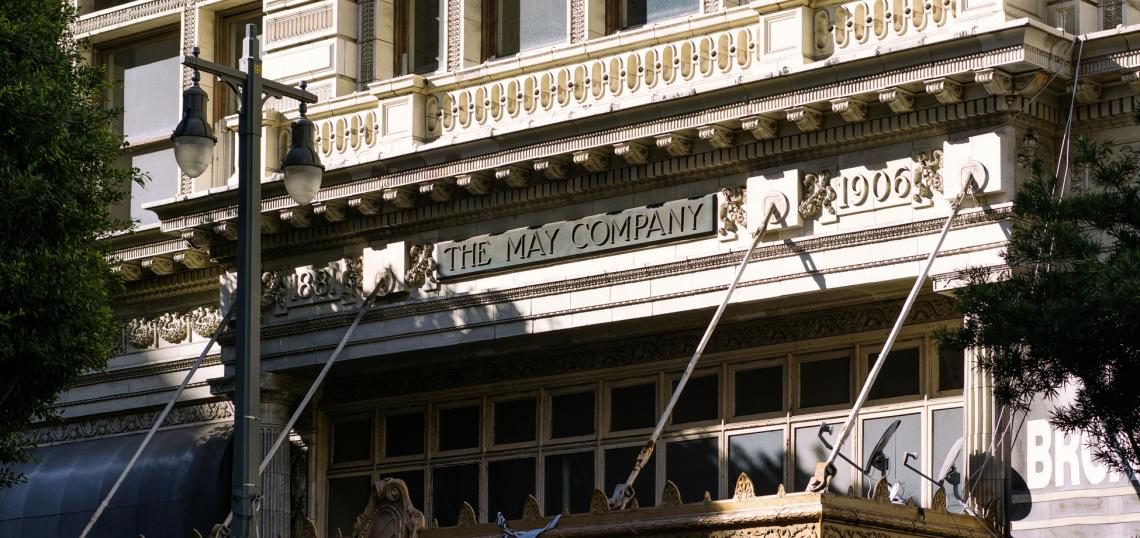Last month, architecture firm Omgivning granted us a first look at the transformation underway at 801 S. Broadway, a historic building in Downtown Los Angeles which was most recently known as the Broadway Trade Center.
The mid-rise structure, formerly a flagship May Company department store, is being converted by real estate firm Waterbridge Capital into a 1.1-million mixed-use complex in the model of New York's Chelsea Market. When completed in 2018, the 108-year-old building will include 400,000 square feet of office space, a boutique hotel and pedestrian-oriented commercial space.
Ground Level
The building's ground-floor will feature a retail and market collective, including approximately 50 restaurants.
Floors 2-5
Prior to construction, the second, third, fourth and fifth floors of the building were used for garment manufacturing, with electrical outlets placed every eight feet to allow for bays of sewing machines. Under Waterbridge's plan, these levels will be repurposed as creative offices, with each level accounting for approximately 100,000 square feet of space.
The building's past as a department store means that it comes complete with a number of ornate fixtures, including historic escalators which were billed as the first on the West Coast. The escalators, designed in the Art Deco style, are functional, but fall short of modern safety standards. The developer has explored the possibility of bringing them up to code, although doing so may eventually prove cost prohibitive. In that event, the escalators would be restored cosmetically, but roped off.
Floors 6-10
Although plans were not finalized until June, the developer is now moving forward with a 100,000-square-foot hotel that would occupy the seventh, eighth, ninth and tenth floors of the building. Previous reports have indicated that the proposed boutique inn would feature approximately 200 guest rooms.
The sixth floor is slated for a private social club. Further information is currently unavailable.
The Roof
801 S. Broadway was built piecemeal over the course of two decades decades, and thus features a seven-story profile along 8th Street and a taller 10-story profile towards 9th Street. Consequently, the developer will repurpose its rooftop with two separate amenity decks.
The lower level already features a number of penthouse structures, one of which will be repruposed as restaurant space with outdoor drinking and dining above. These penthouses will be situated around a grove of olive trees, which will provide additional gathering space. The deck will also include significant landscaping, including vegetable gardens that may provide produce for farm-to-table restaurants on the ground floor.
In the past, the building's roof columns were adorned with a series of globe lanterns. The developer has looked into custom manufacturing fixtures to replicate this in the completed project.
Plans also call for an Olympic-length swimming pool, which will be built so that it may be covered with a hard service to provide a large open space for events and concerts.
The upper roof deck will provide exclusive amenities for hotel guests, including a swimming pool and multiple food and beverage venues.
Nuts & Bolts
The building's basement level will remain in use as a parking garage, utilizing stackers to increase its capacity to a maximum of 600 vehicles. However, this total is still expected to be less than what is ultimately needed for the project.
Structural upgrades include a new mat foundation and three light courts cut into the building. Shear walls are being built to support new amenities, such as the rooftop pool and restaurant space. All elevator shafts and stairwells require a complete retrofit, as they were originally built with hollow-plate tile that is prone to collapse in earthquakes.
Beyond the inherent difficulties in retrofitting a vintage building for modern uses, the project's location posed additional challenges. The building's landmark status and location within the Broadway Design Overlay means that any changes require the approval of agencies ranging from the Department of City Planning to the National Park Service.
Although the building's terra cotta exterior has received a complete restoration by the Spectra Company, the historic nature of the facade made it difficult to modify the structure to improve air circulation. The development team responded by adding louvers to transom windows above the loading dock on Hill Street.
Other obstacles were encountered when modifying the building's interior. For instance, Waterbridge obtained a permit from the Department of Buildign and Safety to demolish the plaster ceilings of the office levels. After installing a fire sprinkler system, the developer had intended to leave the ceilings exposed, as in other creative office settings. However, historic preservation laws mandate that adaptive reuse projects maintain as much of the existing ceiling as possible. A middle ground was found by agreeing to restore the ceiling along the outer walls the building, the idea being that someone looking up from the street would see the portion which is still original plaster.
- Broadway Trade Center Archive (Urbanize LA)







